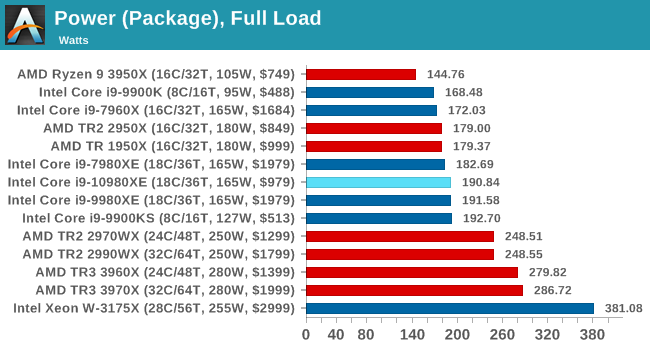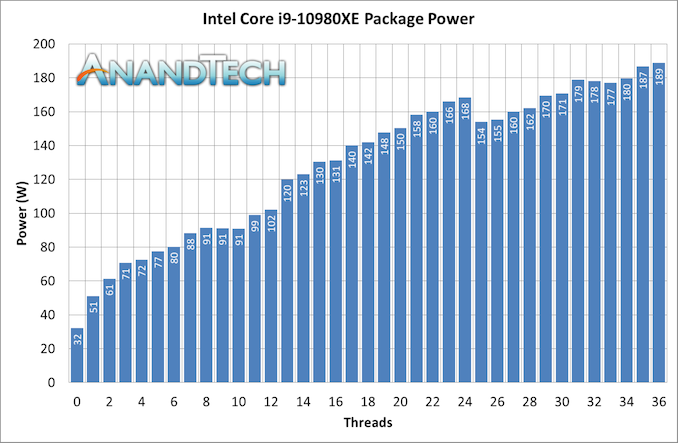It’s a Cascade of 14nm CPUs: AnandTech’s Intel Core i9-10980XE Review
by Dr. Ian Cutress on November 25, 2019 9:00 AM ESTPower Consumption
We’ve covered in detail across multiple articles the story of Intel’s turbo: about how the TDP on the box doesn’t mean a whole lot, the motherboard you’re using can ultimately determine how long your CPU does turbo for, and how the power limits of the processor are ultimately decided by the motherboard manufacturer’s settings in the BIOS unless you change them. Intel only gives recommendations on peak turbo power and the length of the turbo: the only thing Intel defines is the peak frequency based on load when turbo is allowed.
Talking Intel’s TDP and Turbo
Interviewing an Intel Fellow about TDP and Turbo
Comparing Turbo: AMD and Intel
This means that an extremely conservative system might not allow the power to go above TDP, but the system capable of all the power might allow the processor to turbo ad infinitum. The reality is usually somewhere in the middle, but for a high-end desktop platform, where most of the motherboards are engineered to withstand almost anything that comes at it, we’re going to often see the situation of an elongated or persistent turbo.
It’s worth noting that for consumer workloads, most of the work can happen within a reasonable turbo – and thus sustained performance metrics aren’t that important. But today we are testing high-end desktop hardware, and because Intel doesn’t explicitly define peak turbo power or turbo length (it only provides recommendations that motherboard manufacturers can and do ignore), I obviously asked Intel what it believes that reviewers should do when trying to compare performance. The answer wasn’t very helpful: test with a range of motherboards’.
In our previous review of the Core i9-9900KS, I did two sets of tests: benchmarks at the motherboard default, and tests at the Intel recommended turbo settings. The motherboard defaults, for that motherboard in question, were essentially full turbo all the time. Intel’s recommended settings gave some decreases in the long benchmarks, around 7%, but the rest of the tests were about the same.
For this review, we’re using ASRock’s X299 OC Formula motherboard. This is a motherboard designed for high-end and extreme overclocking, and is built accordingly. As a result, our sustained turbo and power limits are set very high. This is a HEDT system, and most HEDT motherboards are built and engineered this way, and so we expect our results here to be consummate with most users’ performance.
For our power consumption metrics, Intel actually does some obfuscation on its high-end platform. Unlike AMD, we cannot extract the per-core power numbers from the internal registers during a sustained workload. As a result, all we get are total package numbers, which show the cooling requirements of the processor but also include the power consumption of the DRAM controller, uncore, and PCIe root complexes.
The TDP of this chip is 165 W – normally Intel recommends a peak power of 1.25x, which would be 207 W, and so the 189 W value we see is under this. The chip we got is technically an engineering sample, not a retail part, although we usually expect the final stepping engineering samples to be identical to what is sold in the market. Despite this, your mileage may vary.
When we compare this peak to other CPUs:












79 Comments
View All Comments
nt300 - Tuesday, November 26, 2019 - link
Do not thank Intel for anything CPU related. They've been milking consumers for many years, confusing people with several different sockets, chipsets, price points etc., this processor not compatible with that socket and so on. They've caused an industry mess with very expensive CPUs and miniscule IPC increases.Who to thank? AMD for launching ZEN and catching Intel by the surprise.
evernessince - Tuesday, November 26, 2019 - link
While your at bringing up irrelevant points from over 7 years ago, might as well thank AMD for X64 as well. Are you going to fellate Intel for everything they've done in the past?Korguz - Tuesday, November 26, 2019 - link
evernessince dont forget the on die memory controller that intel also copied from amd :-)not irrelevant points, they are valid points.. it kinda proves intel likes to milk people for all they are worth, while stagnating the cpu industry, and over charging for their cpus as well. come on, the top sku for 10xxx cpus is 1k less then the cpu it is replacing, and it cant even do that for the most part, may as well just stick with the 9xxx cpus....
Xyler94 - Wednesday, November 27, 2019 - link
While technically Intel was first to 64bit X86, AMD beat intel to X86-64bit, meaning it was both x86(32bit) and x86(64bit) compatible. Intel tried to go 64bit only, but it backfired on them hard, and so they scrambled to do both 32 and 64 bit, but AMD beat them to the punch, so much so Intel had to license that from AMD, and is the sole reason it's still known today as AMD-64Qasar - Wednesday, November 27, 2019 - link
Xyler94 i remember reading that good old microsoft didnt want to have to code windows for 2 different x86-64 instruction sets, so they made intel drop theirs and adopt AMDs instead, as they had already started programming windows for amd64...Samus - Wednesday, November 27, 2019 - link
You realize the only reason Intel lowered the mainstream bracket to the $300 level was competition from AMD's Black Edition CPU's. And after Ivy Bridge, they shot right back up to $400.So stop pretending Intel doesn't price their products based on competition from AMD. That's just ridiculous.
Beaver M. - Monday, November 25, 2019 - link
Yeah well, lower prices are nice and all, but the product isnt that good.Its still the Skylake architecture, still ancient 14 nm, still has dozens of security flaws.
ksec - Tuesday, November 26, 2019 - link
Thanking AMD for Intel's Price Cut and then continue to buy Intel?JlHADJOE - Tuesday, November 26, 2019 - link
Now W3175X needs to drop down to $2000 for the 32-core TR3 to have any kind of competition.UglyFrank - Monday, November 25, 2019 - link
This could make a great workstation processor for me but AMD is still much compelling.